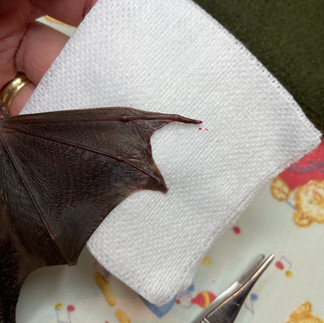Espresso the Bat: Surviving Frostbite
- battyloon

- Dec 22, 2022
- 4 min read
Updated: Dec 28, 2022
On January 11, 2022, three Big brown bats were found outside in single-digit temperatures. It wasn't clear why there were there, but they were in trouble. A couple of amazing rescuers scooped them up and drove them an hour and a half to my home in Pendleton for care.
They arrived in a Peet's Espresso box inside a cooler. There were 2 very blond bats huddled together and a third little bat who was very upset. That one I named Espresso. I named her friends Pete and Decaf. Pete seemed to have escaped harm from the frigid temperatures. Decaf later developed a large blister over her back and tail, which healed on its own with time. Espresso must have been the bat who was found on the ground and not hanging up on the wall -- by the next day, her wrists, feet and tail were swollen, and the tips of her wings felt dry and hard. She was started on medications for pain and swelling along with SQ fluids -- fluids injected just under the skin - to increase the circulation in her wings.
The swelling of her limbs was the first sign of frostbite. The full extent of the damage would not be known for weeks. The first 6 pictures of her wing seen below were taken by shining light through the wing membrane. The first one shows blood starting to leak from damaged vessels, and this bleeding continued to worsen for 4 days before it started to improve. During this first week in care, she liked to snuggle up next to the heat pad. I could tell she was uncomfortable and cranky. But even with all that was going on, she felt good enough to start eating a couple days after she arrived.
Espresso got stronger and gained weight, but had difficulty climbing and was unable to fly. I tried putting her in a small padded flight enclosure with Pete and Decaf, but she stayed close to the ground and stopped eating - so back to her little enclosure she went. During the next 5-6 weeks, the edges of her right wing membrane and her tail membrane turned black and started peeling off. Due to the frostbite, these areas lost their blood supply and the tissue died. Luckily, bat wing membrane heals remarkably well. Even large areas of missing membrane can regrow. Picture 7 shows the wing tip curling as the tissue dies. Dead, black tissue peels off in picture 8, and healing is occurring in the lighter areas seen in pictures 8 and 9.
As Espresso's wing began to heal, I tried housing her with a new friend who also was recovering from severe trauma. This friend, Bobita, was attacked by a cat, and had many puncture wounds in her wing membrane that were healing. The cat also bit right into her belly, causing a severe infection called peritonitis. After surgery to flush out the pus and weeks of antibiotics, the infection was finally resolving, but Bobita was so traumatized that she didn't eat well. When I first tried putting these 2 bats together, I wasn't sure how they would get along – Bobita was very timid and Espresso was still a very high-energy bat – but they really seemed to get along and help each other heal. Bobita started eating on her own and Espresso calmed down a bit! Everything seemed to be going well until I noticed something wrong with Espresso's wing. Unfortunately, as her wing healed, the tips of her finger bones started curling under (picture 10).
She still was not able to fly at all. I tried to gently stretch the tissue in an attempt to straighten the wing, but the wing membrane was so scarred and contracted that it didn't budge. At this point, Espresso had been with me for 3 months, and had been healing so well, that I had to give her a chance to fly again. So I planned surgery to cut the contracted tissue just enough to straighten the wing along with some creative bandaging to hold the wing tip open while it healed.
I needed to prevent that wing from twisting again! In picture 11, she is under anesthesia before surgery. Picture 12 shows the wing after surgery with a clear adhesive bandage called tegaderm used above and below the surgery site, sandwiching the wing tip in between. The wing tip was straightened and held in place with the tegaderm. In order to make it comfortable for her, I folded her wing in the normal resting position and placed a small piece of paper tape around the folded bandage (picture 13). She tolerated this very well! I left the bandage in place for a week and then removed it to check the wing. The wing tip was straight immediately after removing the bandage (picture 14), but her finger tips began to curl again two days later. Anesthesia to stretch the wing and replace the bandage was repeated two more times; bandage on for 7 days then off for 2 days. After wrapping the wing the third time, I left the bandage off and instead started stretching the wing tip. I would do this every other day for the next month until the membrane had regrown in a way that allowed extension of her wing (picture 15). During this time, she was kept in a large flight enclosure so she would also stretch the wing on her own during exercise. This time, when I let her out in the flight enclosure, she flew! She still needed more time to heal and get stronger, but she was a fighter. Nothing would stop her now.
After almost 6 months of perseverance, Espresso was ready to go back home.










































Comments